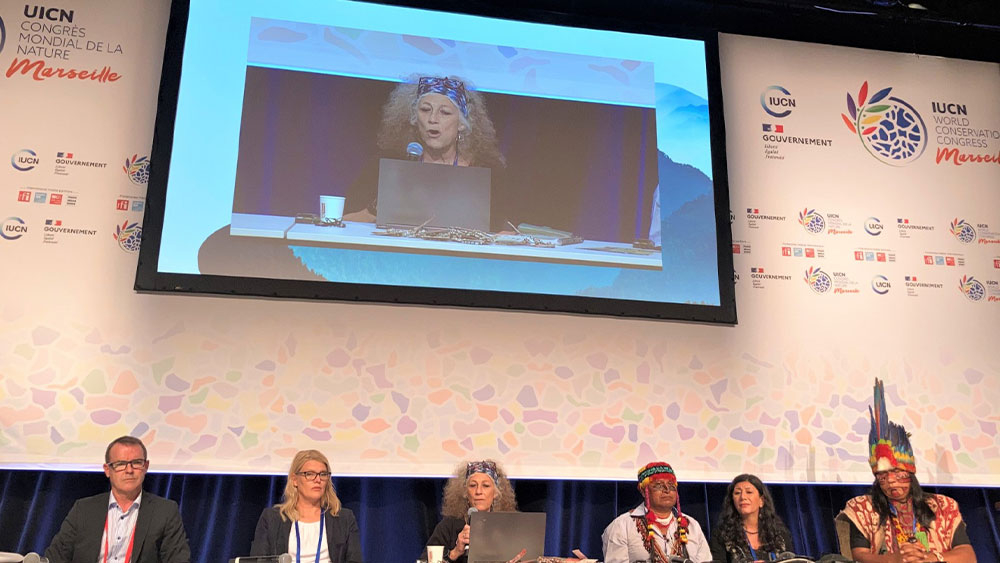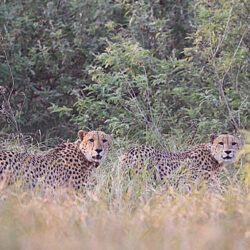Statement by Dr. Laurie Marker – Human-Wildlife Conflict
-

- by Dr. Laurie Marker September 9, 2021

IUCN Human Wildlife Conflict Press Conference – 7 September 2021
Marseilles, France
The world today is in conflict with nature itself. We have forgotten that we are part of nature, animals ourselves, and see things through the lens of us vs. them.
We need to find new ways to live alongside nature, protect biodiversity and habitat, while still allowing for economic security and growth.
We talk about threats to wildlife: habitat loss, climate change, illegal trafficking. But what sits at the heart all threats? The fact that we are in constant conflict with nature and wildlife. In fact, Human Wildlife Conflict may be seen as a surrogate of all our larger social, political and economic issues.
We hear about elephants raiding crops, predators attacking livestock, but the issue is much larger. If we are going to “reverse the Red”, as we propose here at this Congress, we need to rethink our relationship with nature.
However, we do not look at this problem on that scale. Human Wildlife Conflict is often seen as a local, grass-roots problem. And we do indeed have solutions for specific conflict situations. For over 40 years, I have been working in the field with farmers to teach our HWC mitigation strategies and support their implementation. We supply farmers with Livestock Guardian Dogs, through our Future Farmers of Africa Programs, we teach them best practices in integrated livestock and land management to optimize the economic value while avoiding land degradation, we provide them with veterinary medicine support and training to ensure that their livestock are healthy and less vulnerable to predation. These practices help solve conflict situations but require funding as well as the time and effort of the farmer. If we would look at a larger scale though, we will understand that we can act smarter.
First, we can prevent conflict from happening in the first place.
We can diversify livelihoods so that reliance on livestock and specific crops are reduced and the scale of land needed to cultivate crops/raise livestock is minimized. We can grow crops that require less water and less land to grow and reduce the number of livestock raised shifting to plant-based diets. This needs to be done through beneficial governmental policies and subsidies, leadership from business and demand from consumers.
Such diversification and increased economic security for local communities, will also allow increased tolerance to conflict situations when these do occur. After all, some conflict with wild species is inevitable, natural, and has always been in existence. The expectation for zero-conflict is not realistic if we want to share this planet with other species. Bridging the expectation gap will help farmers be conservationists, but we need to help them and increase their resilience to conflict.
Land use planning will also help reduce HWC. When we cut down a forest to plant soy, we are not only losing species, we also fragment the habitat of remaining ones. This fragmentation automatically leads to new and increased conflict with wildlife.
We therefore need a large-scale landscape design to reduce conflict.
Second, in cases where conflict is expected, we can internalize the costs of HWC mitigation into the cost of the end-product.
Working with businesses along the supply chain and encouraging responsible consumerism, we need to promote price premiums and bring the farmers to be the stewards of the earth – through Ecological Stewardship branding, like “Forest Stewardship Certification” and “Wildlife Friendly” production and can inform the consumers through these Wildlife Friendly Seals and governmental requirement for marking the level of biodiversity impact on packaging.
To achieve this, we need to ensure a whole-of-government approach.
How can we facilitate the cross-sectoral change we need to make, when the burden of solving the problem is placed solely with the environmental ministries who, more often than not, do not have the power to stop HWC-provoking government action, be it inappropriate land use planning or detrimental subsidies.
We also need a whole-of-society approach, involving all stakeholders. Businesses, consumers, educators, and conservationists.
HWC problems are real, and grass roots HWC programs are so important, but they are not a one-stop shop for conflict alleviation.
Only when we truly understand that when there’s conflict between a cheetah and a farmer in Namibia, you as businessmen in New York or teachers in Marseille are also affected, will we begin to make true change.
Related Reading
-
February 19, 2024
The Addis Ababa Declaration for Global Cheetah Conservation -
June 2, 2023
Project Cheetah Update




